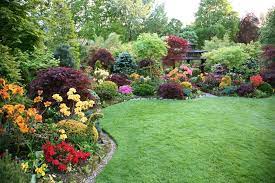Why Landscaping and Gardening Will Transform Your Home
WHY Landscaping and Gardening Can Transform Your Home
High-quality landscaping or gardening can take a lot of effort, time, and money. It takes an expert eye to guess what will work best for your home. Investing in your home landscaping and gardening is a move you will not regret this spring! Here are our top reasons why you want to transform your landscape and garden with Apex this season!
How to Begin Landscaping Your Outdoor Space
Embarking on a landscaping project for your yard doesn’t have to be overwhelming. Here’s a step-by-step guide to help you transform your outdoor space into a beautiful and functional area.
Step 1: Clean and Clear Your Space
Start with a blank slate by clearing out any items that don’t enhance the beauty of your yard. Like organizing a room in your house, remove decorative items that no longer serve a purpose or fit your vision. This includes eliminating excess plants that are no longer healthy or that clutter the space.
Step 2: Design Your Plant Layout
Consider a tiered approach to create an appealing visual effect when planning your flower beds. Organize your plants into three distinct rows based on their height:
- Back Row: Position the tallest plants here, typically facing north to ensure they receive adequate sunlight without overshadowing smaller plants.
- Middle Row: This should feature medium-sized plants to offer a smooth transition in height.
- Front Row: Reserve this space for your shortest plants, ensuring they are visible and enjoy light exposure.
Employing repetition in your flower beds and throughout your garden can create a sense of harmony and order.
Step 3: Add Structural Elements
Incorporating hardscape elements like fences, walls, patios, and decks can significantly enhance the structure and usability of your garden. These features help define the space while offering practical benefits, such as seating areas and clear boundaries.
Step 4: Focus on Variety in Form and Texture
Focus on incorporating a variety of forms and textures to keep your yard interesting throughout the seasons, especially in the absence of blooms. Mix different types of foliage to create a rich tapestry of colors, shapes, and textures that will keep the garden dynamic and engaging.
With these steps, you’ll be well on your way to creating a landscape that looks good and complements your lifestyle and personal aesthetics.
Aesthetics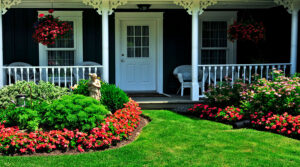
A well-maintained garden, yard, or outdoor space is simply pretty! From trimmed, uniformed hedges to a marvelous water feature, landscaping adds an aesthetically pleasing aspect to your outdoor living spaces. While larger-scale projects can be overwhelming and more time-consuming than cutting the lawn, the results can completely change the landscape. There are even aesthetic choices for whatever concept you are going for. If you aim for a minimalist, old-school, or modern choice, Apex can help you achieve your vision!
Landscaping plays a crucial role in protecting your home from various natural elements. One way landscaping provides protection is by preventing tree roots from causing damage to the house’s foundation. Properly maintained landscaping can help control the growth of tree roots, reducing the risk of them reaching and affecting the property’s structural integrity. Additionally, landscaping can help manage tree branches and vegetation that might otherwise extend toward the home, mitigating potential issues with the roof and other parts of the structure. You can safeguard your home against damage caused by elements like roots and branches by ensuring regular yard maintenance, including tree trimming and lawn care.
Integrating Hardscape Elements into Your Landscaping
When contemplating the addition of a hardscape to your garden, the main aim is to enhance functionality and aesthetics throughout the year. Here are some effective strategies to achieve this:
- Evergreen Planting: Adding evergreen plants ensures your garden retains a structured, vibrant look even in the stark winter months. These plants serve as a stable backdrop amidst seasonal shifts.
- Defining Borders: Erecting walls and fences not only marks the boundaries of your property but also adds a visual appeal that frames your garden beautifully. These structures can be both functional and decorative.
- Creating Outdoor Living Spaces: Consider installing patios or decks to extend your living space outdoors. These structures facilitate a smooth transition from indoor comfort to the natural environment outside, perfect for relaxation or entertaining guests.
Implementing these tips can help you effectively incorporate hardscape elements into your landscape, enhancing its appeal and utility.
Provide a Positive Environmental Impact
Adding some extra greenery to your home is environmentally friendly! Aside from making the yard look great, adding trees and other plants to your landscape impacts nature. Not only do plants produce oxygen, but they also capture harmful pollutants, absorb harmful water runoff, and they can remove carbon dioxide from the air!
Improve Mental Wellbeing 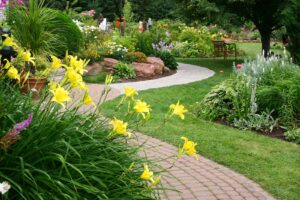
Exploring the impact of landscaping on our well-being reveals a fascinating connection between nature and mental health. Plants have long been studied for their remarkable ability to enhance our emotional and physical state. They serve as natural stress relievers, anxiety reducers, and mood enhancers, offering calm and tranquility. Moreover, the presence of trees and shrubs in a spacious backyard not only adds texture and shade but also uplifts our spirits, contributing to a more positive day-to-day living experience. Not only do trees and shrubs lift mood, but adding a water feature can add a tranquil and beautiful environment to enjoy the warmer weather. By immersing ourselves in such natural surroundings, we can cultivate creativity, boost our mood, and ultimately enhance our overall quality of life.
Landscaping offers a unique opportunity to connect with nature by bringing the outdoors into our living spaces. Whether in a high-rise apartment or a rented home, incorporating plants and greenery into the environment can create a sense of harmony and tranquility. Through activities like container gardening, city dwellers can still enjoy the presence of nature, even in limited spaces. In times of need, such as during the pandemic, many have found solace in tending to plants and creating green spaces within their homes. Landscaping allows individuals to design their own little oasis, where they can relax, unwind, and immerse themselves in the beauty of the natural world. By setting up seating areas, like a bench or a chair under a pergola, individuals can further enhance their connection with nature, creating inviting spaces to enjoy outdoor meals or bask in the calmness of their surroundings. Ultimately, landscaping presents a way to foster a deeper bond with nature, both physically and emotionally, offering a respite from the bustling urban environment and promoting a sense of peace and serenity.
Key Considerations for Designing a Garden Path
When planning a garden path, there are several factors to consider to ensure it complements your outdoor space effectively:
- Width and Direction:
- The width of the path should align with its purpose. A narrower path might be used for intimate, wandering routes encouraging leisurely exploration. In contrast, a wider path suggests a direct route or a more formal passage leading to a specific destination.
- Materials:
- The choice of materials can significantly affect the aesthetics and functionality of your garden path. For a formal look, consider using mortared brick, which provides a clean and classic appearance. If you prefer a more relaxed vibe, gravel can be an excellent choice as it offers a softer, more rustic feel.
Each element of path design plays a crucial role in how your garden is perceived and enjoyed. Adjust these elements based on your garden’s layout and your personal preferences to enhance your outdoor living space.
Transform Your Home with Landscaping and Gardening
Have you ever wondered why concepts like vintage furniture and accent walls are so popular? It is because they make the inside of your home stand out! Luckily, proper landscaping and garden can have the same effect on the outside! Whether you choose a neatly placed row of shrubs, a few trees to fill in some spaces, or a unique water feature, all of these additions can change the perception of your house.
Why should storage and work areas be included in garden design?
Incorporating storage and work areas into your garden design is vital for functionality and aesthetics. Here’s why they should be a fundamental part of planning your garden space:
Convenience and Functionality
- Practicality: Storage sheds and work areas provide a designated spot to keep gardening tools, soil, pots, and other essentials organized and out of sight. This leads to a clutter-free garden space that is both functional and pleasing to the eye.
- Ease of Access: Strategically placed storage and workspaces reduce the time and effort required to retrieve and store gardening supplies, making gardening tasks more efficient.
Aesthetic Integration
- Design Enhancement: Innovative and thoughtful integration of storage areas and workbenches can contribute significantly to the garden’s aesthetic. Dressing up sheds to resemble charming cottages or using decorative elements like paints and plants can transform plain storage into eye-catching features.
- Dual-purpose Features: Furniture with hidden storage capabilities can serve dual purposes. For example, a bench with a hinged seat can provide seating while concealing gardening tools, thus maintaining the garden’s aesthetic while adding functionality.
Overall, including well-designed storage and work areas in your garden maximizes the space’s efficiency and enhances its visual appeal, making gardening more enjoyable and streamlined.
Simple Landscape Design Principles for Enhancing Your Home’s Outdoor Space
1. Incorporating Hardscapes:
Add hardscape features to enhance your garden’s year-round appeal. These include structural elements like stone walls, wooden fences, and decorative patios, which help define and frame the property while facilitating a seamless flow from inside to the outdoor spaces.
2. Embracing Diverse Forms and Textures:
To add visual interest and diversity to your garden, introduce a variety of shapes and textures. Even in the absence of blooming flowers, the use of varied foliage can create an engaging aesthetic with its assorted shapes and textures.
3. Mastering Design Fundamentals:
Effective landscape design centers around foundational principles such as balance, contrast, focal points, repetition, and rhythm. Strategic placement of plants and decor will create a harmonious and inviting garden environment.
4. Integrating Water Features:
Incorporate elements such as fountains or cascading water pools to introduce sound and movement into your garden. Water features not only serve as dynamic focal points but also enhance the sensory experience of the space.
5. Cultivating an Edible Landscape:
Why not make your garden both beautiful and functional? Integrate edible plants like vegetables, herbs, and edible flowers into your design. Arranging them in aesthetically pleasing patterns based on texture, color, and height beautifies your space and provides fresh produce.
6. Designing Practical Pathways:
Install pathways to ensure easy and organized access to different parts of your garden without harming the plants. Pathways function aesthetically to complement the garden’s design and practically to keep visitors’ feet dry and clean.
7. Utilizing Hedges for Definition and Privacy:
A well-placed hedge can serve multiple purposes—it can act as a natural boundary, provide privacy, and even conceal less attractive views. A lush, green hedge can also be a dramatic backdrop in your garden design.
8. Including Storage and Utility Spaces:
Incorporate storage solutions like disguised sheds or attractive compost bins into your landscape design. These are functional and can be styled to enhance the overall look of your garden.
By applying these simple principles, you can transform your home’s surrounding landscapes into aesthetically pleasing and functional spaces that complement the architecture and the natural environment.
Increase Property Value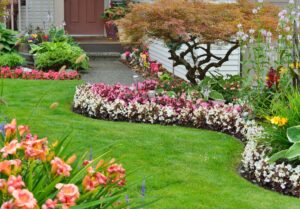
Landscaping and gardening play a significant role in transforming your home. They enhance the appeal and value of a property, making it more enticing to potential buyers. When a property is well-landscaped, its overall aesthetics are greatly improved, attracting more attention from buyers. Additionally, investing in landscaping can increase the value of a property by as much as 15%, potentially allowing sellers to raise their selling price.
Moreover, well-designed landscaping creates a welcoming environment to make a property stand out in the competitive real estate market. Potential buyers are more likely to be drawn to properties with attractive outdoor spaces, as they offer visual appeal and a sense of tranquility. This can work to the sellers’ advantage by making their property more memorable and desirable to prospective buyers.
In summary, landscaping enhances a property’s visual appeal and adds value, making it easier to sell. A well-landscaped property can attract more interest from buyers, increase its perceived value, and set it apart from other properties on the market.

